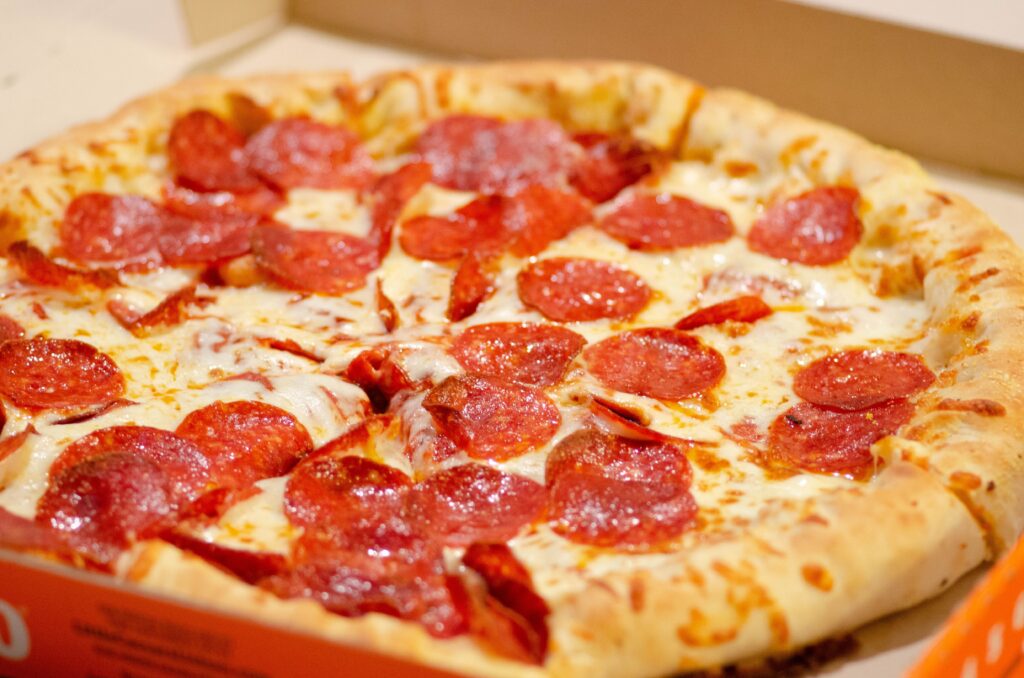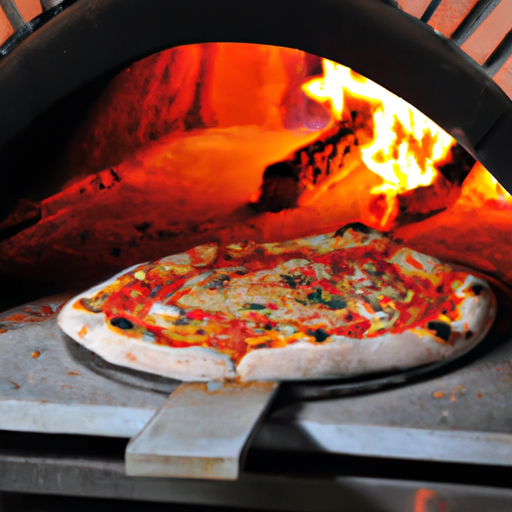In this article, we’ll be discussing how hot a pizza oven should be. You’ll discover the ideal temperature needed to achieve that perfect pizza crust, as well as the different types of pizza ovens and their temperature ranges. We’ll also explore the cooking times required for various pizza styles, such as Neapolitan and New York-style. By the end of this article, you’ll have a better understanding of how hot your pizza oven should be to create a mouth-watering slice of pizza.

How Hot Should Your Pizza Oven Be?
If you’re a pizza lover, you know that the secret to an incredible pizza lies not only in the quality of the ingredients but also in the cooking process. One crucial factor in achieving a perfectly cooked pizza is the temperature of your pizza oven. Different types of pizza ovens operate at various temperatures, each with its own unique benefits and considerations. In this article, I will guide you through the ideal temperature for pizza baking, the factors that affect pizza oven temperature, and the importance of high heat in creating mouthwatering pizzas. Additionally, I will provide tips on preheating and measuring pizza oven temperature, as well as maintaining consistent heat. Safety precautions when dealing with hot pizza ovens will also be discussed. So, let’s dive in and discover how hot your pizza oven should be!
Types of Pizza Ovens
Before we discuss the ideal temperature for your pizza oven, let’s take a look at the different types of pizza ovens available:
Wood-fired Pizza Ovens
Wood-fired pizza ovens have been used for centuries and are favored by traditionalists for their authentic taste and cooking method. These ovens rely on burning firewood to create intense heat, often reaching temperatures of 800 to 1000°F (427 to 538°C). The wood fire gives the pizza a distinct smoky flavor and imparts a beautiful char on the crust. Wood-fired ovens usually have a brick or stone interior, which helps retain heat and distribute it evenly throughout the cooking process.
Gas-powered Pizza Ovens
Gas-powered pizza ovens have gained popularity for their convenience and efficient cooking. These ovens operate by burning natural gas or propane, offering precise control over the temperature. They can reach temperatures between 500 to 700°F (260 to 371°C). Gas-powered ovens are ideal for those seeking convenience and ease of use, allowing for quick heat-up times and consistent temperature control.
Electric Pizza Ovens
Electric pizza ovens are the most versatile option, as they can be used both indoors and outdoors. These ovens rely on electricity to generate heat, making them convenient for home use. Electric ovens typically reach temperatures of 450 to 500°F (232 to 260°C), which is slightly lower than wood-fired or gas-powered ovens. However, they still produce excellent results, especially for those who prefer a milder crust.
Now that you have an understanding of the different types of pizza ovens, let’s explore the ideal temperature range for pizza baking.

Ideal Temperature for Pizza Baking
Understanding the ideal temperature range for pizza baking is crucial to achieve a crispy crust, gooey cheese, and perfectly cooked toppings. The temperature scale used to measure pizza oven heat can vary between Fahrenheit (°F) and Celsius (°C). To convert between the two, remember that 1°F is approximately equal to -17.22°C, and 1°C is approximately equal to 33.8°F. Here is a breakdown of the recommended temperature ranges:
Understanding Temperature Scales
- Fahrenheit (°F): The most commonly used temperature scale in the United States.
- Celsius (°C): The most commonly used temperature scale worldwide.
Recommended Temperature Range
For wood-fired pizza ovens that operate at extremely high temperatures, the recommended range is typically between 700 to 900°F (371 to 482°C). This high heat is essential for creating a crispy and lightly charred crust, while ensuring the toppings are cooked to perfection.
Gas-powered pizza ovens have a slightly lower temperature range, typically between 500 to 700°F (260 to 371°C). This range still allows for excellent cooking results and allows you to adjust the heat levels more precisely.
Electric pizza ovens generally operate within the range of 450 to 500°F (232 to 260°C). While this temperature range is lower than wood-fired and gas-powered ovens, it still provides sufficient heat for baking a delicious pizza.
Factors Affecting Pizza Oven Temperature
Now that we understand the ideal temperature range for pizza baking, let’s explore the various factors that can affect your pizza oven’s temperature:
Pizza Oven Size and Material
The size and material of your pizza oven play a crucial role in its ability to reach and maintain the desired temperature. Larger ovens tend to take longer to heat up but offer better heat retention. Smaller ovens, on the other hand, heat up faster but may struggle to maintain a consistent temperature. The material of the oven, such as brick, stone, or metal, can also impact its ability to retain and distribute heat effectively.
Type of Fuel Used
The type of fuel used in your pizza oven will greatly influence its maximum temperature and cooking process. Wood-fired ovens, as mentioned earlier, can reach the highest temperatures due to the intense heat generated by burning firewood. Gas-powered ovens rely on a steady supply of natural gas or propane, allowing for precise temperature control. Electric ovens, although they reach lower temperatures, are more convenient and accessible for everyday home use.
Insulation and Heat Retention
Good insulation is crucial for any pizza oven as it helps prevent heat loss and ensures consistent temperature throughout the cooking process. Wood-fired ovens, with their brick or stone construction, tend to excel in heat retention. Gas-powered and electric ovens may require additional insulation measures to maintain a steady temperature. Adding insulating materials, such as ceramic fiber insulation or refractory cement, can greatly improve heat retention and reduce heat loss.
Importance of High Heat for Pizza Baking
Now that we have covered the ideal temperature range and factors that affect pizza oven heat, let’s delve into the importance of high heat when baking pizzas:
Crispy Crust and Chewy Texture
High heat is essential for achieving that coveted crispy crust with a slightly chewy texture. The intense heat causes rapid evaporation of moisture from the dough, creating steam within the pizza. This steam helps the crust rise quickly, resulting in a light and airy texture while ensuring a crispy exterior.
Short Cooking Time
When you cook your pizza at high temperatures, it drastically reduces the cooking time. The shorter cooking time prevents the toppings from drying out and losing their freshness. This quick-cooking method ensures that the cheese melts evenly, resulting in a gooey and perfectly melted topping.
Better Flavor Development
High heat is not only responsible for the texture of the pizza but also plays a significant role in flavor development. The intense heat caramelizes the sugars present in the dough and toppings, enhancing the overall taste. This creates a delightful balance between the savory notes of the cheese and sauce and the subtle sweetness of the crust.
Preheating the Pizza Oven
To ensure your pizza is cooked to perfection, it’s crucial to preheat your oven properly. Preheating is the process of heating the oven to the desired temperature before placing the pizza inside. This helps achieve a consistent temperature throughout the oven and ensures even cooking. Here are the steps for proper preheating:
Proper Preheating Process
- Clear out any debris or leftover ashes from previous use.
- Check the gas or wood supply and ensure everything is in working order.
- Open the damper or vents to allow for proper airflow.
- Light the wood or ignite the gas burner.
- Close the oven door or lid.
- Allow the oven to heat up for at least 30 minutes to an hour, depending on the type of oven.
Preheating Time for Different Ovens
Wood-fired ovens typically require the longest preheating time due to the high temperatures they need to reach. It can take anywhere from 1 to 2 hours to fully heat a wood-fired pizza oven. Gas-powered ovens, with their more controlled and precise heating methods, usually require around 30 to 45 minutes of preheating. Electric ovens, being the most convenient and quick to heat up, may only require 15 to 30 minutes of preheating.
Measuring Pizza Oven Temperature
To ensure accuracy when measuring your pizza oven’s temperature, you have two options: using a thermometer or relying on hand techniques.
Thermometers for Pizza Ovens
Investing in a good-quality thermometer designed specifically for pizza ovens is highly recommended. These thermometers usually have a temperature dial or a built-in digital display and can withstand the high temperatures your oven will reach. Place the thermometer in various locations within the oven to ensure a consistent temperature throughout.
Using Hand Techniques for Temperature Measurement
If you prefer a more hands-on approach, you can use a few techniques to gauge your pizza oven’s temperature. One common method is the “hand test.” Hold your hand about 5 inches (13 centimeters) above the cooking surface and count how long you can comfortably keep it there:
- 2 seconds: Very high heat (approximately 800°F/427°C)
- 3 seconds: High heat (approximately 700°F/371°C)
- 4 seconds: Moderate heat (approximately 500°F/260°C)
- 5 seconds: Medium heat (approximately 450°F/232°C)
- 6 seconds: Low heat (approximately 400°F/204°C)
Maintaining Pizza Oven Temperature
Once you have achieved the desired temperature for your pizza, it’s essential to maintain that heat level throughout the cooking process. Here are a few tips for maintaining a consistent temperature:
Monitoring Controls and Adjustments
Pay close attention to the temperature controls or adjustments available on your oven. Wood-fired ovens may require more manual adjustments, such as adding or reducing wood to regulate the heat. Gas-powered ovens generally have control knobs or valves that allow you to adjust the flame intensity. Electric ovens often have digital controls to increase or decrease the temperature as needed.
Tips for Maintaining Consistent Temperature
- Avoid constantly opening and closing the oven door, as this can cause fluctuations in temperature.
- Monitor your pizza closely to prevent burning or undercooking.
- Adjust the cooking time accordingly if you notice any temperature changes.
- Use a pizza peel or long-handled utensil to rotate your pizza within the oven, ensuring even exposure to the heat.
Possible Issues with Pizza Oven Temperature
It’s important to be aware of potential issues that can arise when dealing with pizza oven temperatures:
Uneven Heat Distribution
Uneven heat distribution can occur if your oven lacks proper insulation or if the heat source is not evenly distributed. To mitigate this issue, make sure your oven is adequately insulated and consider rotating the pizza during cooking to ensure even browning and cooking.
Temperature Fluctuations
Temperature fluctuations can occur if the oven door is frequently opened or if the heat source is not properly regulated. To minimize fluctuations, keep a close eye on your oven’s temperature and make careful adjustments as necessary.
Thermal Loss
Poor insulation in your oven can result in thermal loss, causing the oven to struggle to reach and maintain the desired temperature. Insulating your pizza oven effectively can significantly reduce thermal loss and improve overall heat retention.
Safety Precautions with Hot Pizza Ovens
Working with hot pizza ovens requires careful attention to safety to prevent accidents and injuries. Here are some essential safety precautions to follow:
Protective Gear and Equipment
Wear heat-resistant gloves to protect your hands and forearms when handling hot surfaces, such as pizza stones or metal peels. Use a pizza peel or long-handled utensil when placing or removing pizzas from the oven to avoid direct contact with the heat source.
Handling Hot Surfaces
Always exercise caution when handling hot surfaces, as they can cause severe burns. Avoid touching any metal parts of the oven, as they can become extremely hot. Use oven mitts or gloves to handle any equipment or surfaces that have been subjected to high heat.
Fire Safety Measures
It’s crucial to have fire safety measures in place when dealing with any type of pizza oven. Ensure you have a fire extinguisher nearby and familiarize yourself with its operation. Avoid using flammable materials near your oven and always supervise the cooking process to prevent any potential fire hazards.
Achieving Perfectly Cooked Pizzas
In conclusion, understanding the ideal temperature for pizza baking and how to maintain it throughout the cooking process is essential for achieving mouthwatering pizzas. Whether you’re using a wood-fired, gas-powered, or electric oven, each type has its own temperature range and benefits. By considering factors such as the size and material of your oven, the type of fuel used, and proper insulation, you can ensure consistent and delicious results. Remember to follow proper preheating techniques, use thermometers or hand techniques to measure temperature accurately, and maintain a steady heat level throughout cooking. With the right precautions and attention to safety, you can enjoy the process of creating perfectly cooked pizzas that will leave your taste buds longing for more. So, fire up your oven, choose your favorite toppings, and dive into the world of sensational homemade pizzas!

